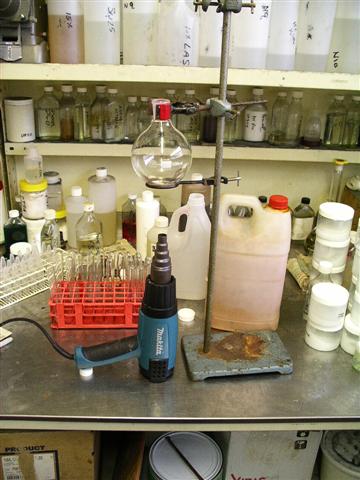
beastmaster - 10-10-2010 at 09:53
Though I have a mantel and hot plate. Their limited because of the size or shape of the different flasks I have. I would need many mantel of
different sizes and my budget doesn't allow that. I've seen in old books of chemist using bunson burners.
My question is could I use a small camp stove(small single burner) to do distillations? I use mostly micro glassware 50ml to 250ml. Also I don't do
any thing(at this time)with flammable or explosive compounds. It seems like with a stove I could control temperature better then I can with a hot
plate and use round bottom flasks if I used a ring or a clamp.
It seems doable, but I've not heard of people using stoves, so maybe there is a reason. They have little compact ones for backpacking at Wal-mart.
Thanks. Beastmaster
1281371269 - 10-10-2010 at 09:59
I've done it before and I see no reason why not. It's very difficult to not overheat the solution, however, especially with cheap stoves meant for
camping where you have fairly minimal control of flame size.
entropy51 - 10-10-2010 at 12:09
If you can't manage a Bunsen burner connected to a small propane cylinder and a regulator, a good alcohol lamp might work for you. I believe it would
be easier to control the heating with a lamp than with camp stove, and a lamp would be adequate for many small scale distillations.
There are lots of suppliers for alcohol lamps and self-contained gas burners.
[Edited on 10-10-2010 by entropy51]
psychokinetic - 10-10-2010 at 16:43
There's another thread around just now of someone looking for a selfcontained.
Is your gas cooker able to have the heat output adjusted? If so, then you're rockin'.
zed - 11-10-2010 at 14:33
I've distilled organic solvents via Bunsen Burner. Mostly via steam distillation.
I wouldn't make it a habit though. Strictly case by case.
Apparatus must be super tight, long long condenser, and good ventilation.
I've done it with Benzene/H2O/Product, it was OK. Anything more flammable, and you are really pushing your luck.
When I say long condenser, I mean three feet long.
[Edited on 11-10-2010 by zed]
1281371269 - 12-10-2010 at 08:53
Now now, there's no need to argue about the length of our condensers.
I understand the need to be cautious, but the danger of using flame with flammables does seem to be overstressed here.
In our A level chemistry classes, we've distilled various flammable solvents (alcohols, alkanes, alkenes) using micro bunsens and bog standard
quickfit apparatus. In our GCSE course we learnt about the processing of crude oil, and in groups of three did our own fractional distillations of
crude oil, again with bunsens as the heat source, to no adverse effect. If these experiments get past the HSE to be done in classes of 20 badly
behaved, laboratory incompetent school kids, then surely the people on this site are capable of carrying them out safely?
psychokinetic - 12-10-2010 at 11:54
Yeah, 600 of us in Chemistry 101 and to our demonstrators' dismay NO ONE blew up their toluene while we were distilling with bunsens.
Magpie - 12-10-2010 at 12:00
I think what minimizes the danger of flames around evaporating solvents is the fact that a fire also requires oxygen, not just heat and fuel. Take for
example an oil refinery flare. No explosion there. In fact, it is a safety device.
zed - 12-10-2010 at 13:31
Ah, but then there was that time, when I was approached by a distraught organic chemistry student, during a Bunsen burner, distillation exercise. He
reported that his solvent was boiling quite well, but there was no condensation!
In fact, his solvent had mostly disappeared; boiled away. Transmutation?
A quick check revealed, that he hadn't turned on the water flow to his condenser.
He had boiled off 100Ml plus, of Carbon Tetrachloride into our mutual breathing air.
Grrrr. Plenty toxic, but fortunately not flammable. Had it been a flammable solvent,
the adventure might have ended tragically.
FrankMartin - 14-10-2010 at 16:18
We have some success with a heat gun. The one shown has temperature settings at its base. Quite good for odd-shaped vessels. The hot air will
flow around the flask.

1281371269 - 15-10-2010 at 05:54
Ah, I've always wondered about using one of those. What sort of temperatures can you get?
FrankMartin - 15-10-2010 at 15:15
The one shown is a "Makita HG6020" with 3 settings plus temperature selections at the base from 1 - 8. Setting I is 50deg only, Setting two is low
blower speed at 50 - 600 degreesC, Setting 3 is high blower speed at 50 - 600degC. We have found setting II is all that is needed. The gun is good
for "flaming" vacuum distillation if the bumping is pronounced. Note the reducing nozzle at the top and various sizes can be purchased for smaller
flasks. We have only needed to heat the flask contents to 250degC. Some other brand guns come with digital temperature readouts. A good gun
will cost less than $80.
